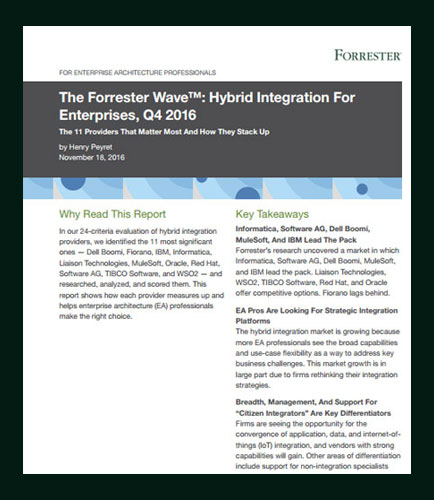
PROCESSING. PLEASE WAIT...


White Paper: Software AG
The hybrid integration market is growing because more EA professionals see the broad capabilities and use-case flexibility as a way to address key business challenges. This market growth is in large part due to firms rethinking their integration strategies.
To assess the state of the hybrid integration market and see how the vendors stack up against each other, the strengths and weaknesses of 11 top hybrid integration vendors was evaluated.
After examining past research, user need assessments, and vendor and expert interviews, a comprehensive set of 24 evaluation criteria was developed and was grouped into three high-level buckets.
This whitepaper shows how each provider measures up and helps enterprise architecture (EA) professionals make the right choice. It highlights:
Hybrid Integration Evaluation Overview
Cloud and Dynamic Integration Requirements Change The Landscape
Vendors Tackle Hybrid Integration from Four Starting Points
Why Hybrid integration will become more essential with the IoT and big data

By: Software AG
Digital business transformation is based on an IT architecture transformation with a roadmap for digital capability implementation. Based on the software platforms, digital companies create enhanced or totally new business models which offer completely new digital customer experiences. Established companies are building up software know-how and are acquiring software companies to accelerate their digital transformation by injecting software innovation capabilities into their core business areas. This whitepaper helps to understand what makes today’s digital challengers attractive to customers and consumers, as it highlights their core competencies and differentiators based on their digital software-based technology. Key takeaways from this whitepaper: Digital challengers separate companies from their customers Implementing digital capabilities for digital use cases Digital companies have a micro services-oriented, scalable IT architecture
By: Software AG
The hybrid integration market is growing because more EA professionals see the broad capabilities and use-case flexibility as a way to address key business challenges. This market growth is in large part due to firms rethinking their integration strategies. To assess the state of the hybrid integration market and see how the vendors stack up against each other, the strengths and weaknesses of 11 top hybrid integration vendors was evaluated. After examining past research, user need assessments, and vendor and expert interviews, a comprehensive set of 24 evaluation criteria was developed and was grouped into three high-level buckets. This whitepaper shows how each provider measures up and helps enterprise architecture (EA) professionals make the right choice. It highlights: Hybrid Integration Evaluation Overview Cloud and Dynamic Integration Requirements Change The Landscape Vendors Tackle Hybrid Integration from Four Starting Points Why Hybrid integration will become more essential with the IoT and big data


 2025 All Rights Reserved | by: www.ciowhitepapersreview.com
2025 All Rights Reserved | by: www.ciowhitepapersreview.com